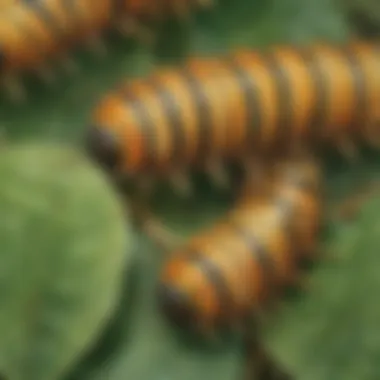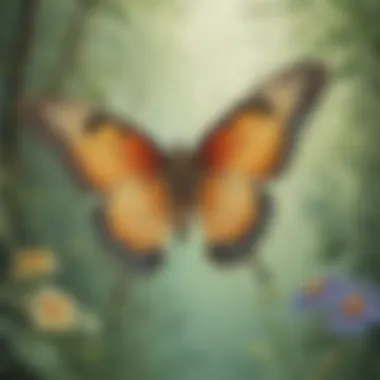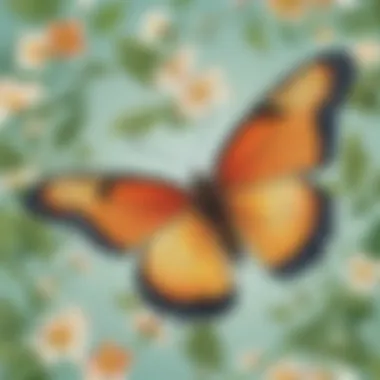Unveiling the Intriguing Life Cycle of Butterflies: Engaging Activities for Young Scientists


Science Fun Facts
To initiate our journey into the mesmerizing world of butterflies, let's first delve into some intriguing science fun facts. Did you know that butterflies taste with their feet? Yes, indeed! These delicate creatures have taste sensors located on their tiny foot pads that help them identify suitable food sources. Another fascinating fact is that some butterflies can fly at incredible speeds, reaching up to 30 miles per hour. Imagine soaring through the air with such grace and agility!
Discover the Wonders of Science
As we continue our exploration, let's unravel the wonders of science hidden within the life cycle of butterflies. By observing these beautiful insects undergo metamorphosis from egg to adult butterfly, young scientists gain insight into concepts of growth, development, and adaptation in nature. Educational videos and animations provide a visual feast, enhancing understanding and igniting curiosity. With interactive learning tools, children can simulate the transformation process themselves, deepening their appreciation for the marvels of the natural world.
Science Quiz Time
Now, it's time to put our newfound knowledge to the test with an exciting science quiz. Engage in interactive quizzes designed to challenge your understanding of butterfly metamorphosis. From multiple-choice questions to brain teasers and puzzles, each quiz promises to stimulate young minds and foster a love for scientific inquiry. Learning through gamification adds a layer of enjoyment to the educational experience, transforming complex concepts into engaging and memorable lessons.
Science Experiment Showcase
In the final segment of our journey, prepare to embark on a hands-on science experiment showcase. By following step-by-step instructions and utilizing the materials list provided, aspiring young scientists can conduct fun and engaging experiments related to butterfly development. From observing caterpillars to creating butterfly-friendly habitats, each activity offers practical insights into the world of entomology. Safety tips and precautions ensure a secure and educational environment, allowing children to explore the wonders of science with confidence and curiosity.
Introduction to Butterflies and Their Life Cycle
The topic of 'Introduction to Butterflies and Their Life Cycle' is a crucial starting point in our exploration of the fascinating world of butterflies. This section serves as the gateway to understanding the intricate stages these marvelous creatures undergo from egg to adult butterfly. By delving into the details of each phase, we offer young science enthusiasts a unique opportunity to appreciate the beauty of metamorphosis and the wonders of the natural world. Understanding the life cycle of butterflies not only educates children but also instills a sense of curiosity and appreciation for the delicate balance of nature.
Understanding the Egg Stage
Identifying Butterfly Eggs
The process of identifying butterfly eggs plays a fundamental role in unraveling the mysteries of a butterfly's life cycle. These tiny, often overlooked structures hold the key to the beginning of a miraculous transformation. By recognizing and studying the distinct characteristics of butterfly eggs, young learners can gain insights into the diversity of butterfly species and their reproductive strategies. Understanding the significance of butterfly eggs enhances children's observational skills and nurtures a keen interest in the natural world.
Egg Development Process


The egg development process marks the initial stage of a butterfly's life cycle, signifying the beginning of growth and transformation. As these minuscule structures evolve, children witness firsthand the marvels of life unfolding before their eyes. Exploring the intricacies of egg development not only educates young minds but also fosters a sense of responsibility towards protecting the habitats where butterflies lay their eggs. By delving into the egg development process, children develop a profound respect for the fragility and importance of these early life stages.
Exploring the Larva (Caterpillar) Stage
Caterpillar Feeding Habits
The study of caterpillar feeding habits offers a window into the unique dietary preferences and behaviors of these remarkable creatures. From voracious leaf consumption to selective feeding patterns, caterpillars play a vital role in the ecological balance of their environments. Understanding the feeding habits of caterpillars not only deepens children's knowledge of entomology but also sparks curiosity about the interconnectivity of species within ecosystems.
Growth and Molting
The process of growth and molting in the larval stage of a butterfly's life cycle is a testament to the resilience and adaptability of these fascinating insects. Children can observe firsthand the remarkable transformations that caterpillars undergo as they outgrow their exoskeletons and emerge with renewed vigor. Exploring the intricacies of growth and molting in caterpillars instills in young learners a sense of awe and wonder at the marvels of nature's adaptive mechanisms.
Unveiling the Pupa (Chrysalis) Stage
Pupa Formation
The formation of a chrysalis marks a pivotal moment in a butterfly's metamorphic journey, signaling the transition from larva to adult. Observing the intricate process of pupa formation offers children a glimpse into the hidden world of transformation taking place within the protective shell. By uncovering the secrets of pupa formation, young scientists gain a deeper appreciation for the resilience and beauty inherent in each stage of a butterfly's life cycle.
Metamorphosis Inside the Chrysalis
The phenomenon of metamorphosis inside the chrysalis is a captivating display of nature's transformative powers. Within the confines of the chrysalis, a caterpillar undergoes a miraculous metamorphosis, reshaping itself into a wondrous butterfly. By studying the process of metamorphosis, children witness the profound changes that occur within this cocoon of transformation, inspiring awe and wonder at the mysteries of growth and change in the natural world.
Witnessing the Adult Butterfly Stage
Butterfly Emergence Process
The butterfly emergence process heralds the final stage of metamorphosis, where the transformed insect emerges from its chrysalis in all its splendor. Children can witness the delicate unfolding of wings, the pumping of fluids, and the gradual hardening of exoskeleton. Observing the butterfly's emergence instills in young observers a sense of respect for the patience and perseverance required for this miraculous transformation.


Colorful Transformations
The colorful transformations that take place during the emergence of an adult butterfly are a sight to behold. From drab chrysalis to vibrant wings, children witness the magic of nature's palette at work. These vivid transformations not only captivate young minds but also underscore the beauty and diversity of butterfly species worldwide, fostering a deep appreciation for the intricate designs and hues found in the natural world.
Engaging Activities for Youthful Science Enthusiasts
Engaging Activities for Youthful Science Enthusiasts holds a pivotal role in this illuminative article, offering children aged 6-12 a hands-on exploration of the wondrous journey butterflies undergo. By engaging in these activities, young minds can grasp the complexities of metamorphosis in a tangible manner. This section spotlights the significance of experiential learning, fostering scientific curiosity, and providing a deeper appreciation for the natural world. It aims to seamlessly blend education with amusement, creating a memorable experience for budding scientists.
Butterfly Life Cycle Craft
Creating a Butterfly Life Cycle Wheel
Creating a Butterfly Life Cycle Wheel involves constructing a visual aid that elucidates the stages of a butterfly's transformation with artistic flair. This craft reinforces the sequential progression from egg to adult butterfly, enhancing children's comprehension through a hands-on approach. The key attribute of the Butterfly Life Cycle Wheel is its interactive nature, allowing youngsters to actively participate in the learning process. This craft is a popular choice for its ability to vividly illustrate a butterfly's life cycle, making it an engaging educational tool for this article. Its unique feature lies in its adaptability for varying learning styles, catering to visual and tactile learners alike.
Crafting a Chrysalis Suprise
Crafting a Chrysalis Surprise involves creating a delightful surprise that encapsulates the mystery and beauty of a butterfly's pupal stage. This craft contributes to the overarching theme by adding a creative element to the exploration of metamorphosis. The key characteristic of Crafting a Chrysalis Surprise is its element of surprise and intrigue, captivating young minds and fostering a sense of wonder. Its appeal lies in the blend of creativity and science, offering children a unique way to engage with the topic. A distinct feature of this craft is its ability to imbue a sense of excitement and discovery, making it a delightful addition to this article.
Observation and Documentation
Keeping a Butterfly Journal
Keeping a Butterfly Journal involves documenting daily observations of butterflies in various stages, encouraging children to engage with the natural world actively. This practice contributes significantly to the educational objectives by instilling a sense of responsibility and attentiveness in young scientists. The key characteristic of Keeping a Butterfly Journal is its promotion of scientific inquiry and detail-oriented thinking, nurturing essential skills in budding naturalists. Its unique feature lies in its capacity to enhance observation skills and encourage reflection, making it a valuable tool for documenting the metamorphic journey.
Recording Metamorphosis
Recording Metamorphosis centers on capturing the intricate stages of butterfly development through detailed notes and visuals. This activity enriches the learning experience by promoting careful observation and recording of scientific data. The key characteristic of Recording Metamorphosis is its focus on precision and accuracy, imparting essential scientific skills to young learners. Its unique feature lies in its ability to chronicle the remarkable transformation process, enabling children to witness and understand the marvels of metamorphosis firsthand.


Butterfly Garden Adventure
Planting Butterfly-Friendly Flowers
Planting Butterfly-Friendly Flowers involves cultivating a garden that attracts and sustains butterflies, creating a haven for these enchanting insects. This practice aligns with the article's themes by fostering environmental awareness and providing a tangible way for children to contribute to butterfly conservation. The key characteristic of Planting Butterfly-Friendly Flowers is its role in supporting biodiversity and ecosystem health, connecting young enthusiasts to the broader implications of their actions. Its unique feature lies in its potential to instill a sense of stewardship and care for the environment, emphasizing the importance of creating sanctuaries for butterflies.
Observing Butterflies in their Habitat
Observing Butterflies in their Habitat entails exploring outdoor spaces to observe butterflies in their natural environment, connecting children directly with the subject of study. This activity enhances the educational experience by allowing youngsters to witness butterfly behaviors firsthand. The key characteristic of Observing Butterflies in their Habitat is its immersive nature, offering a sensory-rich experience that deepens children's understanding of butterfly life cycles. Its unique feature lies in its capacity to instill a sense of awe and appreciation for the intricacies of nature, promoting a profound connection with these delicate creatures.
Virtual Butterfly Exploration
Interactive Butterfly Life Cycle Games
Interactive Butterfly Life Cycle Games introduce a digital dimension to butterfly exploration, offering interactive and educational experiences for young learners. These games complement the hands-on activities by providing a dynamic and engaging platform to reinforce learning concepts. The key characteristic of Interactive Butterfly Life Cycle Games is their ability to merge technology with education, appealing to tech-savvy children while enhancing their understanding of butterfly life cycles. A unique feature of these games is their interactive nature, encouraging active participation and knowledge retention in an engaging virtual environment.
Virtual Butterfly House Tours
Virtual Butterfly House Tours transport children to virtual sanctuaries where they can observe butterflies in lifelike settings, fostering a sense of discovery and wonder. These tours supplement real-world experiences by offering immersive insights into butterfly habitats and behaviors. The key characteristic of Virtual Butterfly House Tours is their ability to simulate real-life encounters with butterflies, providing a safe and informative platform for exploration. A unique feature of these tours is their capacity to transcend physical boundaries, enabling children to embark on virtual expeditions to butterfly havens worldwide, expanding their horizons and cultivating a global perspective.
Conclusion: Inspiring Curiosity and Learning
In this conclusive segment of our exploration into the mesmerizing life cycle of butterflies, we aim to inspire young minds by nurturing a love for science. Fostering curiosity and a thirst for knowledge among children aged 6-12 is crucial in promoting scientific inquiry and environmental awareness. By engaging in interactive activities that unravel the intricacies of metamorphosis, children can develop a deeper appreciation for the wonders of the natural world. Inspiring curiosity and learning in this context goes beyond mere educational outcomes; it cultivates a sense of wonder and a desire to protect and preserve our environment for future generations to come.
Nurturing a Love for Science
Encouraging Scientific Inquiry
Encouraging scientific inquiry among young learners is a pivotal aspect of fostering a love for science. By promoting curiosity, critical thinking, and problem-solving skills, scientific inquiry equips children with the tools to explore the world around them. The key characteristic of encouraging scientific inquiry lies in encouraging children to ask questions, make observations, and form hypotheses. This active engagement with the scientific process not only enhances their cognitive abilities but also instills a lifelong love for learning. While the unique feature of encouraging scientific inquiry lies in its hands-on approach to learning, allowing children to interact directly with scientific concepts, its main advantage in this article is the promotion of independent thinking and discovery.
Fostering Environmental Awareness
Fostering environmental awareness plays a vital role in instilling a sense of responsibility towards nature in young minds. By highlighting the interconnectedness of all living organisms and the impact of human actions on the environment, children can develop a newfound respect for the natural world. The key characteristic of fostering environmental awareness lies in emphasizing the importance of conservation, sustainability, and eco-conscious choices. By integrating environmental education into learning experiences, children can grasp the significance of protecting biodiversity and reducing their carbon footprint. The unique feature of fostering environmental awareness is its proactive approach to instilling environmental values, empowering children to become stewards of the planet. Its advantage in this article lies in linking scientific knowledge with real-world environmental issues, encouraging children to take meaningful action for a sustainable future.







